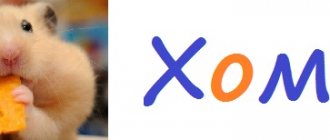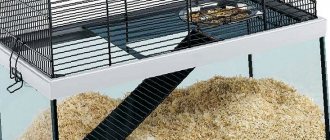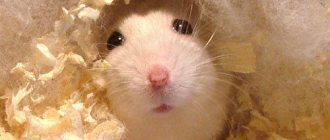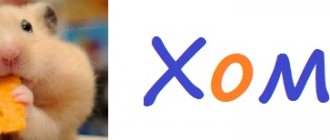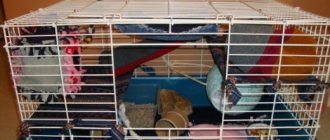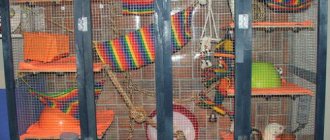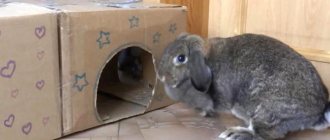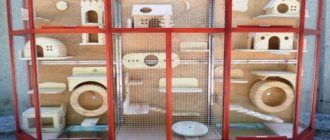Rats love houses and will use them for nesting, playing and sleeping. Hideouts mimic the burrows and nests rats live in in the wild and will give your pets a sense of security. Always provide at least one house per rat cage and try to provide many different types, especially if you have multiple rats.
Why is it necessary to equip a cage house?
Some people think that houses are just a cute extra thing for a rat's cage, but in fact they are truly essential to the well-being of your pet rodent. In the wild, rats are the prey of predatory animals, so they dig holes for safety and protection, and at home, where they cannot burrow, shelter helps them feel safe.
There are also five other reasons to buy a rat house, including:
- Stress.
Fear can be one of the stressful situations. A pet rat can be frightened by loud barking from a dog, the voices of strangers, and similar loud noises. Then the rat can crawl into the house and feel safe. If your pet does not have a place to hide, then nervous tension may cause health problems. - Cold
. If the room temperature is low, the rat may need a place to stay warm. Rats usually insulate their house with whatever materials they can find. Also, several rats sleep in one shelter, keeping each other warm. - Draft.
Rats need a house with thick walls that will not allow cold air to pass through. After all, hypothermia can cause colds or more serious illnesses. - Age.
Older rats are much less active and prefer to spend more time in shelters. They also often have health problems, so they need to feel calm and safe. - Sunlight
. Rats are sensitive to direct sunlight and hot temperatures, so the house will be an excellent shelter for them from overheating.
Advice!
Place some treats in the new hiding place. Acceptable treats: apples, carrots, broccoli, tomatoes and bananas.
Buying a squirrel
Buying a squirrel is not easy.
This is a rare animal that must be kept indoors and taking it home from the forest is strictly prohibited - it is a wild animal, it cannot be tamed, but it can easily be tortured to death. In this case, the squirrel may get hurt. The purchase can be made at a specialized nursery; if there is one nearby, you can try placing an order at a large pet store. In the worst case scenario, you can try going to the zoo, but it’s better not to hope for it.
Squirrels
Do not buy protein from a poultry market if your health is important to you.
The price of an animal varies from 5,000 rubles and above, which can also be attributed to the advantages of a pet.
Characteristics of a rodent
- Proportionally curved body;
- Color: fiery brown, silver-fawn in winter;
- There are long dark tassels on the ears;
- The tail is soft;
- Eyes black;
- Body length - up to 31 cm. Tail of the same length;
- Weight: up to 1 kg;
- Life expectancy at home is up to 15 years. For comparison, in nature they live 3-4 years.
The squirrel has a playful, curious character and boundless energy. He can spin the wheel for hours, jump off it in one second, make a couple of dozen circles around the floor of the cage and jump into the wheel again.
Mobile search
The only thing is that at first they are distinguished by cowardice, but this is only a precautionary measure, then the squirrel will become gullible. But we warn you: petting and hugging like a kitten is unlikely to work, they don’t like the tenderness of the body, this is not a guinea pig
But there are also exceptions.
In addition, you have to constantly communicate with them, because squirrels have a very short memory, they quickly run wild and this is fraught with bites.
Diet
You should feed the squirrel the same things it eats in the wild:
- Berries;
- Fresh fruits and vegetables;
- Pine and spruce seeds;
- Mushrooms;
- Nuts (except almonds, this is poison for proteins);
- Sprouts, sprouts.
Contrary to popular belief that they are herbivores, squirrels eat insects, their larvae, frogs and shelled eggs. You can drink both water and milk. We fill the feeder 2 times a day - morning and evening, 50 grams at a time. To prevent stocks from rotting, do not add too much food.
Squirrel eats
Never put sweet, fried, salty proteins or any other food on our table.
Beautiful furry animal
Of course, a squirrel is a very beautiful animal, but before you buy it, think again, and you really need it, because there are more domestic rodents, fewer bites and scratches. And if you don't change your mind, be prepared to spend a little more time than you expected; after all, the beauty in the photo above is a wild animal.
And remember: we are responsible for those we have tamed!
How to choose a house for a rat
The best house for a rat is the one that meets all its needs. Choosing the best house for your pet depends on a number of factors, such as the size of the animal and the space available in the cage. The house must be at least 25cm x 15cm x 10cm in size. Rats are one of the largest rodents, so be careful when choosing a house as some accessories for small animals may not be suitable for larger rats. But don't worry if you end up with a small hiding place, as your smart rats will probably find a way to use it as a toy.
It is also necessary to rely on the activity level of the pet. Baby rats tend to be more active, so they will benefit from a large house with plenty of space for fun and play. For an older rat, a smaller shelter is suitable, since it will not frolic in it, but will only use it for rest.
The shelter should have a passage large enough for your furry friend to fit through easily. At the same time, the pet should feel maximum comfort and tranquility in the house. Each rat should have its own private shelter with two passages so it doesn't feel crowded, and those living together should have a house large enough for several rats.
The next criterion for considering a rat house will be its material. Rats love to chew and chew, and some materials are better suited for this purpose. Most often, rat houses are made from:
- Tree.
Rats love to chew on things, so a wooden shelter can be used to make both an excellent house and a sharpener for the animal’s teeth. However, some types of wood are treated with chemicals or stained, which can be harmful to your pet. You may also have to replace a wood house more often than other materials. When purchasing a wooden accessory, make sure that the material is not treated or toxic. - Plastic.
Houses made from this material are cheap and easy to clean, which guarantees the absence of mold and mildew. However, plastic is quite poorly breathable, so it has poor ventilation. Plus, rats tend to chew things, and if the plastic is cheap and filled with dangerous chemicals, your pet could get sick. If you do decide to use plastic, make sure it has plenty of holes for ventilation and is non-toxic. - Herbs.
Natural fiber shelters are a great choice for your rat because they are made from safe, chewable, and often edible grasses. They provide pleasure to your pet and satisfy his natural chewing instincts. However, such a house will not last long, especially if your rat chews on it often. - Ceramics.
Like plastic houses, ceramic houses are very easy to clean. They will also last a long time as they are chew resistant and can withstand minor impacts. Plus, they are non-toxic, so you don't have to worry about your rat ingesting any unwanted chemicals. But just like plastic, it doesn't have as much air in it, although it may be a little better at absorbing moisture. - Textile
. These accessories are easy to clean in a regular washing machine. But fabric shelters will not last long, since this material is very easy to chew through. Therefore, if your pet likes to sharpen its teeth, think twice before purchasing a fabric shelter.
Choose 1 or 2 house options for your rat to start with. Since they spend most of their lives in a cage, having some variety keeps them active and involved in their surroundings. See what your rat prefers and use that information to make decisions about future purchases, but don't be afraid to introduce them to something new.
If your rat is avoiding a particular hutch, chances are it is either dirty and needs cleaning, or you purchased the wrong size hutch.
Options for designs and materials
Pet stores offer a variety of designs and shapes, as well as manufacturing materials. You can choose simple, rectangular ones with flat roofs, or fancy shapes in the form of a castle or mushroom, in beautiful colors.
Made of plastic
Plastic shelters are considered convenient and practical. They are easy to wash and attach to the bars of the cage. Prices for such designs are affordable. But in such a shelter in the summer the rodent will be uncomfortable, since the walls do not “breathe”, it will be stuffy inside. Windows partly solve the problem.
Wooden
Rodents really like wooden structures. They quickly adapt them not only for relaxation, but also in order to sharpen their constantly growing teeth. When a rat is not litter box trained, the house will quickly become dirty and smell bad. It will have to be changed after 3-4 months. Even if the rodent is clean, during the same period the house will be “gnawed” beyond recognition.
Basket houses
Lightweight shelters for rodents in the form of baskets made from tree bark, twigs and straw are environmentally friendly and aesthetically pleasing. Animals really like these designs. However, they fail very quickly thanks to sharp teeth and rat curiosity.
Made of ceramics
Ceramic products are environmentally friendly, hygienic structures. They are cool in the summer and look great. Rodents will not be able to sharpen their teeth on them. But they can accidentally break them. This must be monitored carefully. Broken shards are dangerous.
Fabric
Rats really enjoy fabric hammocks, which they use for privacy and relaxation. The good thing is that they can be washed. Colors can be very diverse. They look attractive and cozy. Rats are not hot in a hammock in the summer and not cold in the winter. It’s easy to sew a hammock from an old thing. The only negative is that there is no guarantee that the rodent will not chew the soft tissue.
How to make a house with your own hands?
You can buy a ready-made house, but it is much more interesting and economical to make a rat house with your own hands.
You can get creative and make it taking into account your ideas about design. The main thing is that it turns out safe and comfortable for the pet.
Cardboard shelter
Cardboard is the most accessible and cheapest material for this purpose. Suitable containers include household appliances, shoes, confectionery, cereals, and juices. You can use regular cardboard or multi-layer corrugated cardboard. The second option is warmer and more stable.
These cardboard houses can be cut into any shape. With all its advantages, it must be admitted that this is the most short-lived design. Enough for a maximum of 2 weeks. Cardboard gets dirty quickly and absorbs moisture and odors. It is best to cut the house without a bottom, so it will stay clean longer.
Plastic bucket house
Nowadays, many dairy products come in large plastic buckets that are the perfect size for a rat's house. This could be a container for ice cream, mayonnaise, or sour cream.
Food grade plastic is durable. Rats rarely chew them. Such shelters provide good protection from sunlight, drafts and prying eyes.
In a plastic container, just make holes for entry and turn it upside down. The role of the roof will be played by the base of the bucket. You can make a house for a rat this way in 5 minutes.
Shelter from a flower pot
For a rat, you can make a shelter from a clay flower pot of suitable size. The result is an eco-friendly and cozy house that absorbs excess moisture, is easy to clean and does not smell. The main difficulty is to fix the pot in the cage on its side.
Papier-mâché is used
Papier-mâché makes a structure that is warm in winter and cool in summer. You'll have to work a little to make it:
- Make a glue mass from flour and water in a ratio of 1:1.5. A small amount of food coloring may be added.
- Cut white blank paper into strips.
- Inflate the balloon to the size of the house.
- Dip strips of paper in glue and cover the ball with them in several layers
After 3-4 days the glue will completely dry. The ball is pierced and additional holes are made for windows and entrance. The inside of the home is filled with strips of rags or paper for comfort.
Under no circumstances should you use newspapers; the rat will be poisoned by the printing ink.
Made of wood or plywood
If you have wooden slats or waste plywood sheets in your house, you can make an eco-friendly wooden house.
The blanks are cut with a saw or jigsaw. The walls and roof must be fastened with furniture dowels. Nails or screws should not be used. Carried away by grinding down its teeth, a rodent can accidentally break them by bumping into metal. Do not use toxic glue. The pet may be poisoned. For this reason, purchasing non-certified wooden houses is dangerous for rodents.
Homemade wooden houses can be made very beautiful and aesthetically pleasing. We must not forget that they are short-lived. Difficult to wash, absorbs odors.
Examples of homemade houses
Rat houses are available in many stores and come in a variety of types, but many rodent owners prefer to create their own shelters. Often, pet owners make the following structures:
- A house made from an empty tissue box.
Creating such a shelter is very simple. It is necessary to remove the plastic sections of the box that partially cover its upper opening and place the future house in the cage on its side. The hole should be vertical to the ground for easy access to the rat's entrance. Next, line the bottom of the box with something soft, like cage litter or strips of an old cotton T-shirt, to turn it into a cozy haven. Of course, such a shelter will not last long. Check your tissue box every 1-2 weeks and replace the lining and box if necessary. - House made from a plastic bowl.
A plate can easily be used to make a cave-shaped shelter. Drill a large hole in a plastic bowl to create a cave. Take an old plastic bowl and a drill and make a hole in the side that the rat can fit through. Then place the bowl upside down in the cage. This creates a sanctuary for the rat to rest in and will also last longer than a tissue box house. Line the bottom of the house with something soft for the rat to sleep on, such as pieces of an old flannel shirt or a fleece blanket. Check the cave liner every 1-2 weeks and replace it when it becomes dirty. Clean out the cave completely at least once a month. - House made from a flower pot.
A potty can also be an excellent hiding place for a pet rat. You only need to file one side of the pot. You can lay out paper or fabric at the bottom of the shelter.
What part of a watermelon can you give to a squirrel?
The squirrel should be given a small piece of red pulp just for sweetness. Before doing this, you need to cut the crust. It is not necessary to feed the degu often and a lot, because its body is suitable for eating cereals.
It is better not to pamper your rodent with this delicacy more than twice a week. In addition, watermelon is a diuretic, so you often have to change the protein droppings.
Watermelon rinds and seeds on the degu menu
Many owners of decorative squirrels believe that they can limit themselves to eating watermelon peel. But this is not true, because it often contains toxic substances that can harm the health of the animal.
Also, there is nothing healthy in the scab, so you shouldn't feed it protein. Watermelon seeds can be given to degus gradually
it is important to observe moderation in everything
Seeds should be given raw; frying is prohibited. Seeds can be collected for the winter. To do this, they are dried and systematically added to the degu’s main food.
How to choose the right watermelon?
The product you plan to process with protein must be fresh and juicy.
Don't give degus:
- unripe and rotten watermelon;
- the aroma of the berry pulp should be fresh and pleasant, without foreign odors;
- a good watermelon has a uniform flesh color;
- You can’t feed it to an animal if the inside of the flesh is shiny with yellow-white streaks. This indicates the presence of nitrates.
Composition of the product
Watermelon seeds accumulate many nutrients necessary for the development of the embryo and sprouts. The kernel contains fats, proteins, carbohydrates, vitamins and minerals. Experts identify the following composition of watermelon seeds:
- more than 50 g of fat per 100 g of product;
- 32 g protein;
- 12% carbohydrates, which means 15 g;
- high energy value 557 kcal;
- among the vitamins there are folates; there are more than 54 mg of them in the seeds. They take part in the metabolic process, the work of the heart and blood vessels;
- 3.6 mg of niacin - improves the condition of blood vessels, thins the blood, normalizes heart function, acid eliminates the risk of stroke.
Despite the rich chemical composition of the seeds, they need to be fed with protein in limited quantities. The allowed rate is 5 pieces per week. You can't give every day. Treats are always given after the main meal has been taken.
The benefits and harms of watermelon seeds
Zoologists give squirrel gifts of sunflowers, zucchini and pumpkin seeds. On the Internet and on forums you can find discussions among rodent owners about whether it is possible to give a degu watermelon. Experts say you shouldn't feed watermelon, but you can.
These are healthy snacks. When taking the seeds, stress in rodents is reduced, immunity is increased, blood circulation and microcirculation are stabilized. This is an excellent prevention of thrombosis.
If given daily, the seeds can cause obesity and protein poisoning. Food should be consumed in moderation. Can degu replace watermelon seeds? Veterinarians respond negatively.
The juicy pulp contains a lot of sugar, which can cause hyperglycemia and a sharp increase in blood sugar levels. Chilean protein flavors are useful in limited quantities. Otherwise, you will harm your pet's health, cause obesity, intoxication and diabetes.
DIY rodent house
You can also build a playhouse for rats, in which they can run freely and relax. You can build a simple rat house out of cardboard boxes and then expand the house and make it as functional as you want.
Step 1:
Take 2 cardboard boxes, approximately 30cm x 30cm x 20cm. Shipping boxes are a great choice for the hut, but any sturdy cardboard box will do. The optimal size for boxes is 30 x 30 x 20 cm, but make sure they are spacious enough for your rat to move comfortably inside. If you decide to expand your rat house, you will find that there are many types of cardboard boxes - shoe boxes, cereal boxes, etc. - that make useful building materials.
Step 2
: Cut off the top flaps or close them and cut holes in them. If you want the rat to be clearly visible at all times, simply cut off the top flaps of both boxes with scissors or a hand knife. However, your rat may prefer a more enclosed box, so consider sealing the top flaps with packing tape and cutting 1-2 holes in each box.
Step 3:
Cut 10cm doorways on one side of each frame. Using a ruler and knife, cut a 10cm square hole in both boxes. Alternatively, you can use a coffee can lid (or similar) to outline the round doorways around the sides.
Step 4:
Line up the doorways and glue the boxes together. Place the 2 boxes side by side so that the doorways line up exactly. Either use tape to secure the 2 boxes in place, or squeeze some white glue between the walls and press them together.
Step 5:
If desired, cut windows into the other walls of the boxes. Measure and cut 7.6-10.2cm square (or round) windows on the sides of each box. This will give you more angles of view of the rat.
The house is ready! In such a spacious shelter, the rat will be able to run and play freely, as well as just relax. However, this shelter option is far from the only one and you can use a variety of materials to create it. But don't use wood you found outside to create a rat house. It may contain parasites or other insects that could harm your rat, or the wood may not be safe for your rat to chew on.
An option for real needlewomen - a closed knitted hammock
Knitted houses for rats, created by yourself, are an option that will allow you to create colorful and comfortable housing for your pet. A knitted house is called a hammock. The hammock can be closed or open.
The principle of creating a closed hammock:
- The easiest way to create a design is with a hook. It is advisable to use acrylic threads for knitting.
- Knitting starts from the bottom. You can make the bottom double and put a piece of plywood in the resulting pocket.
- It is possible to knit in the round or knit individual parts and then sew them. The simplest option is circular knitting.
- It is worth casting on five air loops and closing them in a circle. Next, knit several rows adding 1 loop to each row. The number of such rows is determined by the desired size. This knitting will allow you to form the floor of the house.
- After making the bottom of the house, you can start knitting the walls. Rows are knitted without additions. Their number will determine the lifting height for the move.
- You need to count 10 loops and do not knit them until the opening is formed.
- Then the unknitted loops are closed using a chain of air loops.
- The roof is knitted in the same way as the floor. Only instead of adding loops in each row, a decrease is made.
In order not to think about how to shape the product using various frames, you can simply hang the hammock at several points. The house will stretch and take on the desired shape.
Distinctive features of degus
The Chilean squirrel is small in size but has a long tail. The body is covered with thick brown fur with a yellowish tint. There are animals that are lighter in color. Their hair is greyish and silver. The natural color is called agouti: the hair at the body is light, darkening towards the tip. Domestic breeders have bred colorful degus of different colors: cognac, blue, speckled, gray. Some are similar in color to the Siamese cat. In nature, there are agouti-colored individuals. Rodents are small, but larger than mice and dormouse. To choose the right cage for degu squirrels, you need to know how many centimeters the length of its body is:
- in an adult common degu, the body length can reach 22 cm. Larger Chilean squirrels are found in nature. Their body length was 40 cm, but this is considered rare. The animal is active during the day. At night, rodents crawl into holes. Squirrels live in families. It includes 1-2 boys, 3-4 girls and children. The leader is the greatest degu;
- Degu bridges are not as large as the common species. Their body length is 9 cm. Animals prefer rocky terrain and beech forests. They don't build dens. In times of danger, they hide under stones and tree roots. Squirrels climb trees well and move quickly along steep rocks. Bridges Degus are nocturnal;
- Moon-toothed degus are small rodents. Its body length is 12 cm. The animal prefers mountains. Animals can be found at an altitude of 5 thousand meters above sea level. Tolerates large temperature changes well. During the day, animals are inactive. These are nocturnal squirrels. They have well-developed night vision;
- The body length of the degosonoid is up to 18 cm. The animals are nocturnal. They spend the day in burrows, but the tunnels are not as elaborate as those of common species. Rodents live under cacti and under the roots of acacias. Some animal species are common in mountain ranges. They don't dig underground here. They nest in rock crevices;
- Pacific degus prefer a humid climate. Lives by the ocean. Its limbs are suitable for digging holes and climbing trees. Grows up to 20 cm.
All Chilean squirrels have the same tail length of 10-12 cm and are evenly covered with bristles. Towards the end the hair becomes longer. They form a soft brush. Its length is about 6 cm. The animal raises its tail: it is slightly rounded towards the back. You always want to touch the brush on the tail, but you shouldn’t. The squirrel loses the skin from its tail and runs away. Thus, she is saved from danger. The animal bites the exposed part of the tail. The wound heals quickly and the tail never grows back.
The body weight of the Chilean squirrel is from 130 to 300 g. The weight of newborn puppies does not exceed 14 g, but they grow quickly. In the first 2 weeks they add up to 3 g. After that, up to 6 weeks, their weight increases by 15 g per day. Puppies show maximum growth at 4-8 weeks of age. The weight gain per day can reach 24 g. At 8 months, the weight of the female reaches 220 g, the male - 300 g. Individuals enter the stage of puberty. Crossbreeding can be done at 12 months.
All degus have a very developed sense of smell. They remember smells and keep them in their heads for a long time. Their sense of smell helps them hide from danger. If a domestic rodent is offended by one of the family members, a cat or a dog, it will remember the smell of the attacker and will always show aggression towards him.
